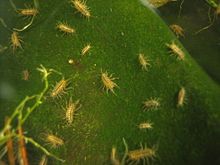| Asellota | |
|---|---|

| |
| Asellus aquaticus, Asellidae | |
| Scientific classification | |
| Domain: | Eukaryota |
| Kingdom: | Animalia |
| Phylum: | Arthropoda |
| Class: | Malacostraca |
| Order: | Isopoda |
| Suborder: | Asellota Latreille, 1802 [1] |
| Superfamilies | |
Asellota is a suborder of isopod crustaceans found in marine and freshwater environments.[2] Roughly one-quarter of all marine isopods belong to this suborder.[3] Members of this suborder are readily distinguished from other isopods by their complex copulatory apparatus. Other characteristics include six-jointed antennal peduncle, the styliform uropods (a character shared with some other isopod groups), the fusion of pleonites 5, 4 and sometimes 3 to the pleotelson, and absence of the first pleopod in females.[3][4]
Classification
[edit]The suborder Asellota comprises these families:[5] Some classifications also include the Microcerberidea within Asellota.[5]
|
Janiroidea Sars, 1897
|
Aselloidea Latreille, 1802
Stenetrioidea Hansen, 1905
Gnathostenetroidoidea Kussakin, 1967
|
References
[edit]- ^ "Asellota". Integrated Taxonomic Information System.
- ^ J. K. Lowry (October 2, 1999). "Asellota". Crustacea, the Higher Taxa. Crustacea.net. Archived from the original on January 20, 2009. Retrieved January 29, 2009.
- ^ a b Richard Brusca, Vania R. Coelho and Stefano Taiti. "Suborder Asellota". Guide to the Coastal Marine Isopods of California. Retrieved January 28, 2009.
- ^ George D. F. (Buz) Wilson. "Definition of the Asellota". University of Sydney. Archived from the original on June 23, 2005. Retrieved January 28, 2009.
- ^ a b J. W. Martin & G. E. Davis (2001). An Updated Classification of the Recent Crustacea (PDF). Natural History Museum of Los Angeles County. pp. 132 pp. Archived from the original (PDF) on 2013-05-12. Retrieved 2009-12-14.
- ^ http://www.marinespecies.org/aphia.php?p=taxdetails&id=118369 WoRMS
External links
[edit]
Well, that’s interesting to know that Psilotum nudum are known as whisk ferns. Psilotum nudum is the commoner species of the two. While the P. flaccidum is a rare species and is found in the tropical islands. Both the species are usually epiphytic in habit and grow upon tree ferns. These species may also be terrestrial and grow in humus or in the crevices of the rocks.
View the detailed Guide of Psilotum nudum: Detailed Study Of Psilotum Nudum (Whisk Fern), Classification, Anatomy, Reproduction